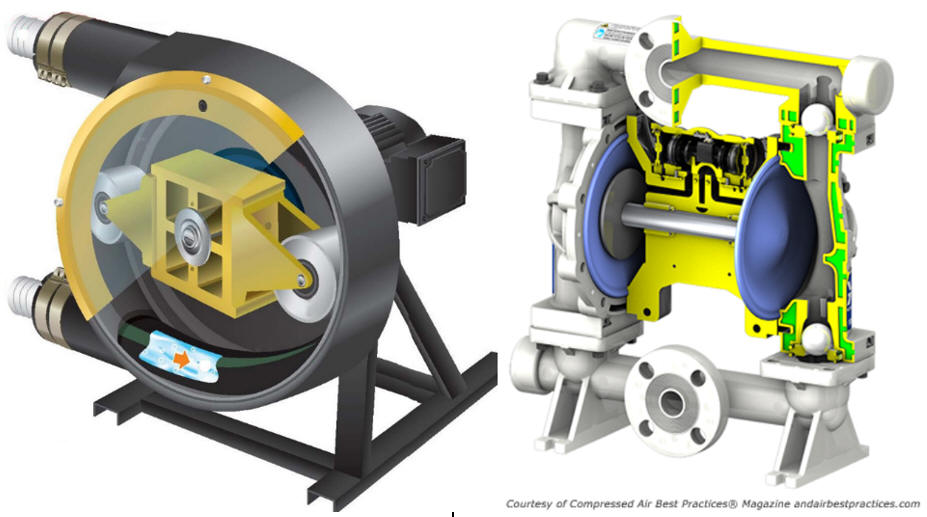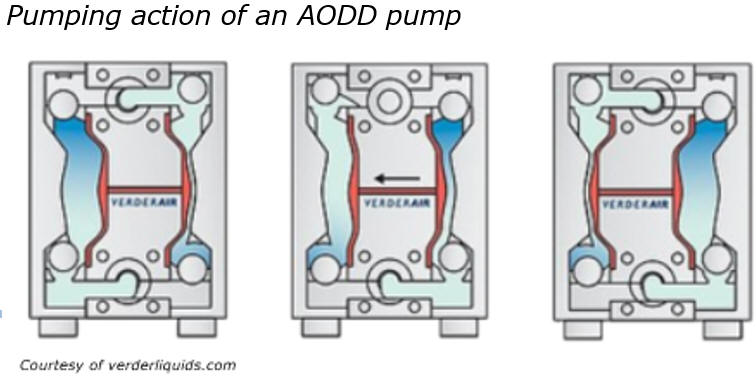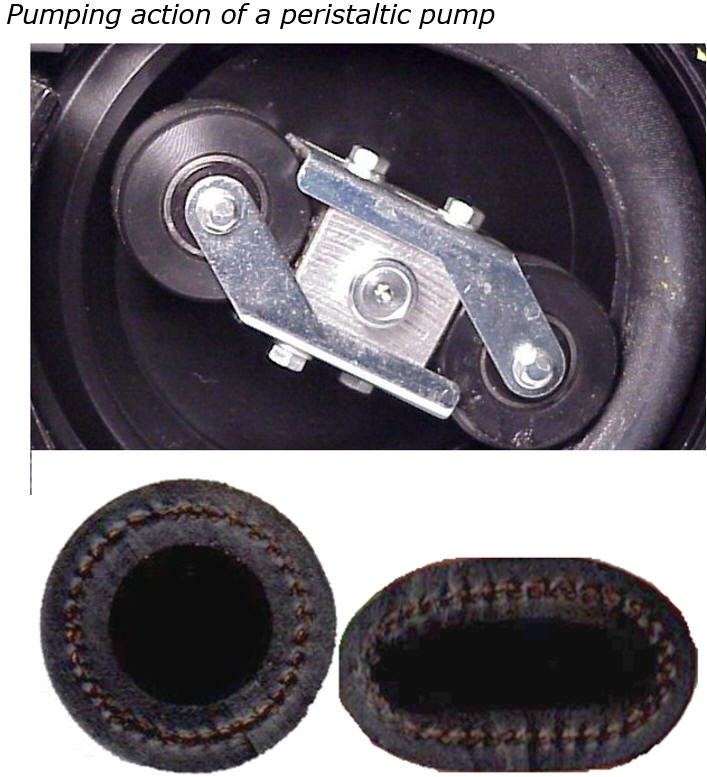Peristaltic Pumps Compared to Air Operated Double Diaphragm
Pumps
Comparison of pump application and designs
Industrial peristaltic pumps and air operated double diaphragm pumps are commonly used in industrial settings for fluid transfer applications and mostly for transferring relatively low viscosity liquids. This article describes several advantages peristaltic pumps have over air operated double diaphragm pumps (AODD), particularly in the general industrial, chemical processing and food and beverage industries.
One of the main advantages of peristaltic pumps is their ability to handle abrasive fluids, which contain particles that can foul or accelerate wear of internal pump components. This may range from gray water to black water, reclaimed acid as well as slurries for water treatment. The particles within, whether inherently “hard”, gelatinous or fibrous, accelerate wear of the check valves used within AODD pumps to control the direction of flow. The unique design of a peristaltic pump, which uses a resilient hose to create a seal around the fluid, allows it to pump fluids containing high percentages of solids, whether they are hard, deformable or fibrous, without damage to the pump.

Comparison of Pump Designs
An AODD pump operates by using diaphragms to increase and decrease the pump chamber; fluid is drawn into the pump chamber through a one-way check valve and exits through another one-way check valve. These check valves control the flow path and they are also a wear component which is easily fouled. The diaphragms are actuated via compressed air acting against a piston and they are also a wear component, having X number of flexes to failure.
A peristaltic pump has no check valves, instead its flow path is enforced by the direction of hose compression. The compression of the hose entraps fluid between two or more points, transferring the fluid from inlet to outlet.

Both diaphragms and hoses are wear components; the diaphragms only last X number of flexes and the hoses only last X number of compressions. However, the efficiency or wear of AODD diaphragms is accelerated during cavitation situations due to continuous flexing and sometimes even physical damage due to vapor bubble implosions (which can also damage the check valve assemblies). Peristaltic pumps cannot experience cavitation because their resilient hose is never pinched 100% and the hose simply remains compressed in a high vacuum situation, so the roller action is not generating “waste” compressions.
 Cavitation
is pretty common, mostly caused by clogged inlet filters but could also
occur when pumping viscous fluids due to restrictions within piping –
attempting to displace more liquid than is physically available is what
causes cavitation.
Cavitation
is pretty common, mostly caused by clogged inlet filters but could also
occur when pumping viscous fluids due to restrictions within piping –
attempting to displace more liquid than is physically available is what
causes cavitation.
There is definitely a wear aspect to some industrial fluids where a peristaltic pump would perform more reliably and efficiently. This is especially important for applications where exposure to harsh chemicals to equipment and personnel are a concern. Less downtime and a simple hose swap contribute to a safer work environment and overall process efficiency.
AODD pumps also require a clean and dry source
of compressed air to operate; peristaltic pumps are typically driven with an
electric motor but can be driven with hydraulic and air motors when required
for hazardous duty locations. Generating clean and dry compressed air is
more expensive and labor intensive than using electricity.
Flow Control
The pumping rate for an AODD pump is dependent upon the differential pressure of the compressed air and the discharge pressure required to move the fluid. An increase in air pressure or decrease in discharge pressure results in an increased pumping speed, meaning it can be difficult to ensure a constant flow rate without adding compressed air and liquid flow control valves to the system. This is not an issue for electrically driven peristaltic pumps, they displace a fixed volume of fluid per revolution which is easily controlled with a variable frequency drive for an effective turndown ratio of at least 4:1.
Peristaltic pumps are used to transfer and meter chemicals such as chlorine and fluoride for water treatment applications. Their ability to pump harsh chemicals with precision make them a better choice than an AODD pump for these types of applications.
Peristaltic pumps are also known for their low shear, which is beneficial in applications where the fluid being pumped is sensitive to shear stress. This makes peristaltic pumps ideal for applications in the food and beverage industry, where delicate fluids such as fruit juices, syrups, sauces, and purees are often used. In contrast, air operated double diaphragm pumps can cause more shear stress on the fluid due to the directional check valves within the pump.
In conclusion, industrial peristaltic pumps offer many advantages over air operated double diaphragm pumps, including improved efficiency, reliability and precision dosing while also being less costly to operate. These advantages make peristaltic pumps an ideal choice for fluid transfer and metering applications involving hazardous fluids, shear sensitive products and fluids containing solids.
Our website https://innovativepumps.com provides significant engineering and application information for our entire product line of sealless positive displacement pumps and live chat support is available to assist you.





